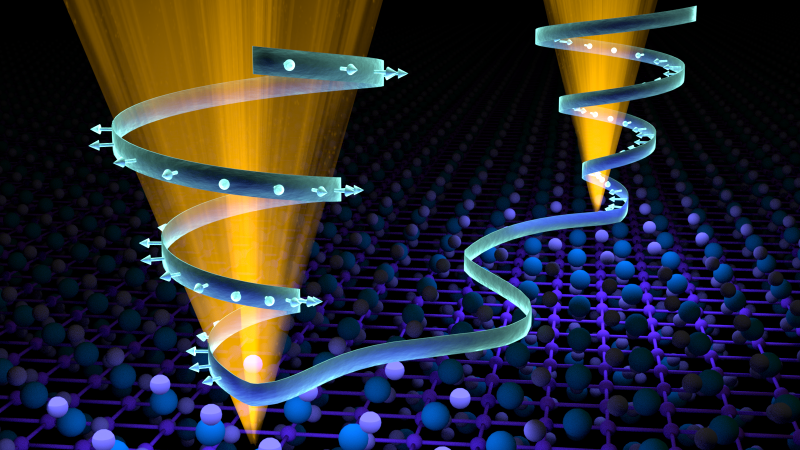The observation of an abnormal state of matter in a two-dimensional magnetic material is the latest development in the race to harness novel electronic properties for more robust and efficient next-generation devices.
Neutron scattering at the Department of Energy’s (DOE’s) Oak Ridge National Laboratory (ORNL) helped a multi-institutional team led by Tulane University investigate a graphene-like strontium-manganese-antimony material (Sr1-yMn1-zSb2) that hosts what researchers suspect is a Weyl semimetal phase.
The properties of Weyl semimetals include both magnetism and topological semimetal behavior, in which electrons—or charge carriers—are nearly massless and immune to conduction defects. The team’s results are published in the journal Nature Materials.
The neutron scattering measurements at the High Flux Isotope Reactor, a DOE Office of Science User Facility at ORNL, and magnetic field studies at Florida State University’s National High Magnetic Field Laboratory uncovered key mechanistic behaviors underpinning the quantum material’s relationship between electron transport and magnetism.
“Weyl semimetals are kind of the Holy Grail in physics right now,” said Alan Tennant, chief scientist at ORNL’s Neutron Sciences Directorate. “Some of these types of materials are showing quantum behavior at room temperature, which is precisely what has to be achieved to provide a path toward quantum electronics.”
Significantly stronger than steel, and an excellent conductor of heat and electricity, graphene is a highly desirable building material for electronics. However, it lacks traditional magnetic properties necessary to achieve greater control over electron transport. That’s why researchers are searching for Weyl semimetals, says Qiang Zhang, a visiting scientist from Louisiana State University (LSU) working in ORNL’s Shull Wollan Center—a Joint Institute for Neutron Sciences.
“Weyl semimetals are rare, and most of them are nonmagnetic. We found one that is magnetic,” Zhang said. “If we can better understand the electronic behaviors we found in this material, it could significantly speed up computer and smart phone technologies.”
The electrons in graphene have a famous property: They form a “Dirac cone”, in which their momentum and energy are related in much the same way as happens in light.
Unlike graphene, the team’s material exhibits traditional magnetism, or ferromagnetism, meaning the electrons align in a parallel arrangement like the north and south poles of a typical bar magnet. But it also exhibits antiferromagnetism, in which the electrons point in opposite directions to their neighboring electrons.
The magnetism has a profound effect, Tennant explains. The opposing motions of the electrons cause the Dirac cone to rip apart or split in two, so that two new cones are formed. This breaks a principle known as time reversal symmetry, meaning the system would not be the same if time were rewound. “Think of a spinning top going in reverse,” he says.
When the two cones break the time reversal symmetry, they induce a Weyl semimetal state in which the electrons lose mass.
The significance is that electrons, like many particles, have mass. Because of that—in addition to increasingly smaller sizes of transistors and similar charge-carrying materials—electrons have a tendency to bottleneck, or create traffic jams. In Weyl semimetals, the electrons are more like charge carriers that behave as if they are nearly massless, which makes them highly mobile.
Examining a small, high-quality crystal grown at Tulane University, the team was able to determine the magnetic structure of Sr1-yMn1-zSb2, using neutrons at the Four-Circle Diffractometer instrument at the High Flux Isotope Reactor.
Neutrons are ideal tools for identifying and characterizing magnetism in almost any material, because they, like electrons, exhibit a flow of magnetism called “spin.”
“We discovered two types of ferromagnetic orders and found the experimental proof of the time-reversal symmetry breaking, likely creating a Weyl state in Sr1-yMn1-zSb2. This makes this system a wonderful candidate to study the effect of the time-reversal symmetry breaking on the electronic band structure,” said Zhang.
Zhang is part of LSU’s Louisiana Consortium for Neutron Scattering, which is funded by DOE’s EPSCoR program—the Experimental Program to Stimulate Competitive Research.
UT-Battelle manages ORNL for the DOE’s Office of Science. The Office of Science is the single largest supporter of basic research in the physical sciences in the United States, and is working to address some of the most pressing challenges of our time. For more information, please visit http://science.energy.gov/.—by Jeremy Rumsey








